We were without gas for three weeks. It’s a long story, but in essence the previous tenant hadn’t paid his gas bill since 2009, the landlady hadn’t changed the contract when we moved in 4 1/2 years ago, and I had blithely assumed that because the invoice said boldly “gas & power” that I was paying for gas and power. Apparently, I wasn’t.
A couple of weeks ago I wrote briefly about trying a new approach to my 50% wholewheat loaf. The results were good enough to make me want to try again, after having found some good strong Manitoba flour. And all I can say is, I’m impressed.
I’m not going to repeat the recipe here. All the details, and lots of explanation, are on Trevor Jay Wilson’s website, and I have little to add. The secret is the very long autolysis. The idea is to wet the flour before adding any leavening at all. There are lots of good reasons to do this. It fully hydrates the flour, which gives the process of gluten formation a headstart. It also gives some of the enzymes in the flour a chance to convert starches to sugars, providing more food for the leaven and a slightly sweeter crumb. But the real key, with wholemeal flour, is that it softens the sharp-edged bits of bran in the wholemeal flour, with the result that they don’t do nearly as much damage to the gluten network. And that means a better rise and more oven spring.
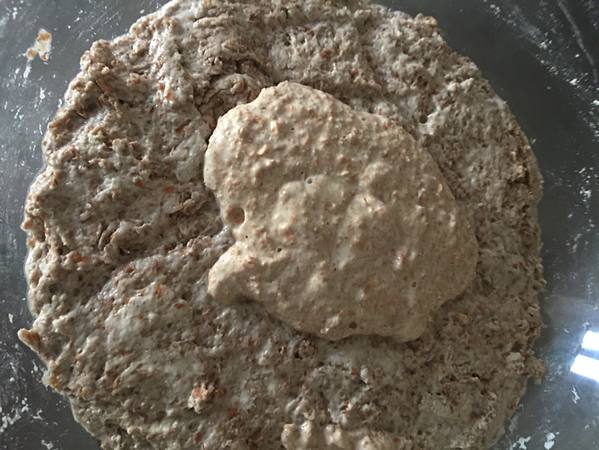
I’ve done relatively brief autolysis before — half an hour or so. But Trevor calls for an overnight autolysis. That’s the big difference. What goes into the fridge a shaggy mass is almost a fully fledged dough next morning. (You take it out of the fridge just before bed time to let it gradually come up to room temperature.) Then it is just a matter of working in the starter, doing a few increasingly gentle stretch and folds, shaping, proving and baking.
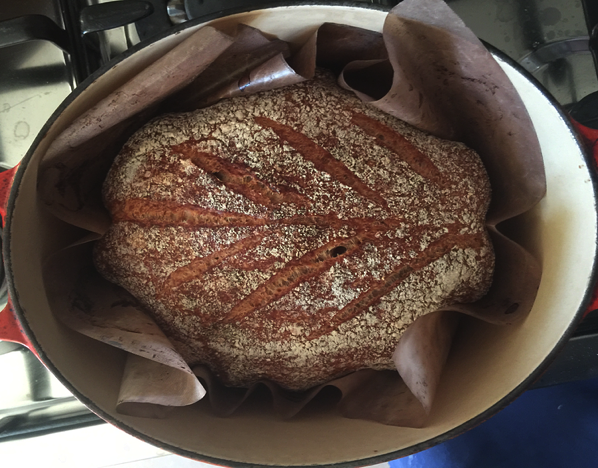
And the result, this time, was beyond my expectations.
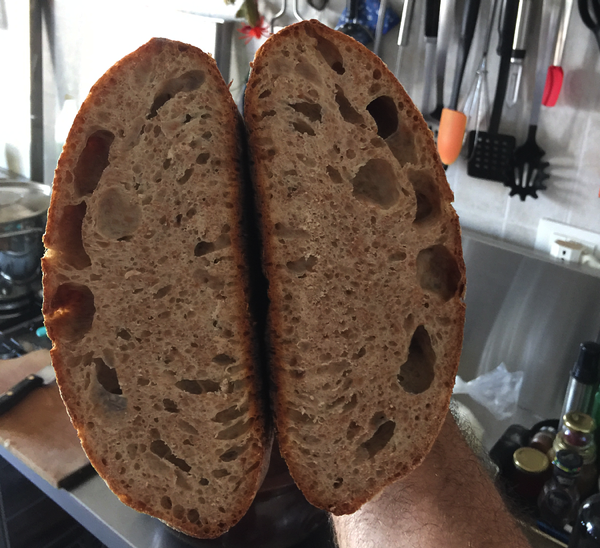
The cross section doesn’t really do justice to the open, airy texture. And the flavour was good too. Not too sour, nor really sweet, but chewy and good.
I think I’m sold on an overnight soak now for anything that contains more than a smidgen of wholewheat flour, and am currently waiting for my standard 50% wholewheat with a multigrain soaker to finish proving so I can see whether it makes any difference to that loaf.
Over on Instagram I became fascinated by the bread videos of Trevor Jay Wilson, marvelling at how gentle he is with his dough and how wonderfully that dough performs for him. His website is a treasure trove of sound, practical advice that gives far more detail than the little clips on Instagram. I decided to follow his technique for a 50% wholewheat sourdough, with a twist. He uses bread flour; that is, strong flour, with a high protein content that builds a strong gluten network to support the heavier wholewheat. Strong flour goes by the generic name Manitoba in Italy, even if it doesn’t come from Canada, but for some reason stocks have dried up. Neither of my two regular suppliers have any at the moment. So I had to use ordinary flour, and it is undeniably weaker.
You can see that in the photos.
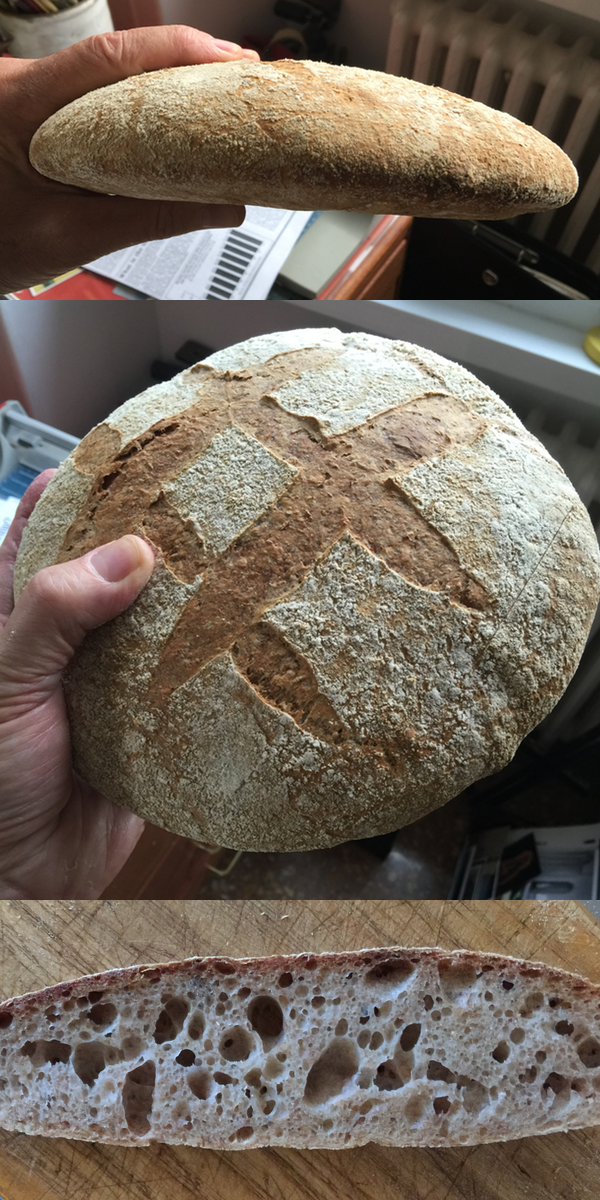
I won’t do a proper write-up here until I have cracked it to my own satisfaction. I will note that the rise was definitely less than I had hoped for, but that was not entirely surprising given the weakness of the dough. But the crumb structure was great, as was the flavour.
I’m definitely going to keep trying this method, once I manage to score some stronger flour. And I’m going to keep watching Trevor Jay Wilson as I try to improve my dough handling skills.
One tip I’ve picked up: use a wet hand, when necessary, to avoid stickiness.
Sultana and pine nuts
I fancied something different, so returned to a loaf that I haven’t made in a couple of years at least. And in so doing I discovered that the images that accompanied the original post had gone missing. So, I’m going to shamelessly steal from myself and just copy most of that original post over.
Continue reading
A very good carrot cake
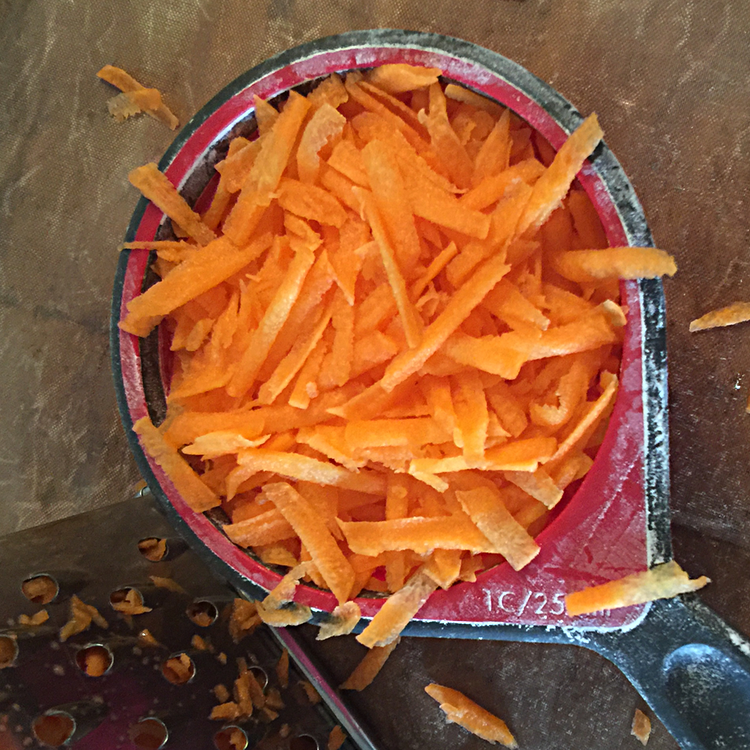
The Main Squeeze is partial to carrot cake. I am too. So when an occasion to celebrate rolled around, I went looking for a good recipe. There are thousands of them, many with an awful lot in them besides carrots. I had two considerations in mind. First, I didn’t want too big a cake. We’d never get through a three-layered tower of delight. Secondly, not too sweet, so anything that had more sugar than flour was automatically out. In the end I found one that was scaled for a loaf pan rather than a round cake tin and that didn’t seem too sweet. Of course it was written in American, so I translated the amounts to Sensible, made a few modifications and have no hesitation in claiming it now as my own.